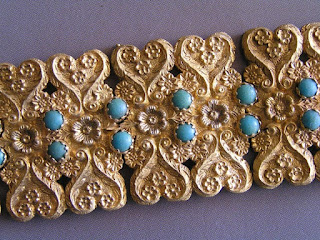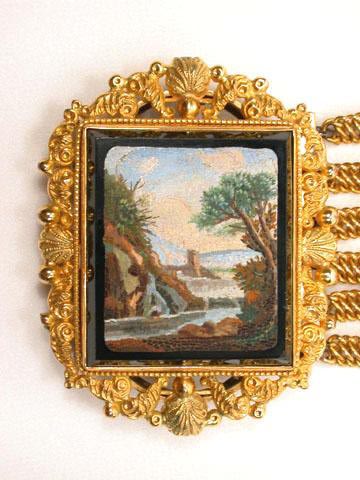
Pinchbeck has become almost a general term for all jewelry made out of substitutes for gold. Also known under various fancy names like Tombac, Prince's Metal and Mosaic Gold, the ingredients of all the alloys are copper and zinc, the same metals which are used in compounding brass, but in Pinchbeck the zinc is used in a lesser proportion. In brass it varies from one to three, to two to three, while in Pinchbeck, it is about one part to ten. There must, however, it seems to me, have been some further trade secret, either in the process of manufacture or in the after-treatment, to account for the much superior wearing qualities and color of Pinchbeck. Possibly a slight wash of gold was used on the surface to prevent tarnish. This has remained in the hollows,and on the rubbed parts the very friction which wore away the gilding would serve to keep the metal in bright condition.The metal was first put on the market by a certain Christopher Pinchbeck (1670 - 1732), who is said to have invented it,and it soon became exceedingly popular. The appearance, especially when new, was so like gold, that it appealed at once to all those who, either from thrift or lack of means, thought real gold too expensive a material to use for the less important articles of personal ornament.
Another motive for wearing it, is that things made of this metal made a special appeal to travelers In those days when a journey of even a few miles out of town led through roads infested by thieves and highway robbers, careful folk preferred not to tempt these "gentlemen of the road" by wearing expensive ornaments unless traveling with a good escort; so not only would a traveler with a base metal watch and buckles lose less if robbed, but owing to the freemasonry which existed between innkeepers and postilions and the highwaymen, they were actually less likely to be stopped, as it was not worthwhile to run risks for such a poor spoil. Therefore while of course much of it was made to enable the wearers to make a fair show at a small expense, a good deal was also made for the "nobility and gentry," who used such things as watches, sword-hilts, and buckles made of it.>p>
 >
>A great deal of jewelry was made out of it, and it was very well patronized; but it aroused the indignation of the workers in the genuine metal, and legal proceedings were instituted, with the result that after a time the alloy was only allowed to be used for such things as shoe buckles, buttons, etc., which did not much compete with the regular goldsmith's work. It has been said that with Edward Pinchbeck's death the secret of the correct method of making it, whatever it was,died out, but metal bearing a close resemblance to it continued to be used well into the nineteenth century, until the process of electro-gilding made it easy and cheap to deposit a wash of gold on any metal as required. Brass articles with a coating of gold are often passed of as Pinchbeck, and even if they are without the gilding some dealers think "Pinchbeck" sounds better and helps to sell their stock. If unacquainted with the respective appearance of the metals, brass may be distinguished by having a metallic smell, especially when a little warmed by being held and rubbed in the hand. Rolled gold which is sometimes offered for it is quite a modern invention and consists of an exceedingly thin plate of gold on a background of inferior metal. The gold forms a part of the sheet, wire or whatever it is, before being made up, and is not a wash or coating added after.
Genuine Pinchbeck has the color and the weight of 20k gold. Another motive for wearing it, is that things made of this metal made a special appeal to travelers In those days when a journey of even a few miles out of town led through roads infested by thieves and highway robbers, careful folk preferred not to tempt these "gentlemen of the road" by wearing expensive ornaments unless traveling with a good escort; so not only would a traveler with a base metal watch and buckles lose less if robbed, but owing to the freemasonry which existed between innkeepers and postilions and the highwaymen, they were actually less likely to be stopped, as it was not worthwhile to run risks for such a poor spoil. Therefore while of course much of it was made to enable the wearers to make a fair show at a small expense, a good deal was also made for the "nobility and gentry," who used such things as watches, sword-hilts, and buckles made of it
A great deal of jewelry was made out of it, and it was very well patronized; but it aroused the indignation of the workers in the genuine metal, and legal proceedings were instituted, with the result that after a time the alloy was only allowed to be used for such things as shoe buckles, buttons, etc., which did not much compete with the regular goldsmith's work. It has been said that with Edward Pinchbeck's death the secret of the correct method of making it, whatever it was,died out, but metal bearing a close resemblance to it continued to be used well into the nineteenth century, until the process of electro-gilding made it easy and cheap to deposit a wash of gold on any metal as required. Brass articles with a coating of gold are often passed of as Pinchbeck, and even if they are without the gilding some dealers think "Pinchbeck" sounds better and helps to sell their stock. If unacquainted with the respective appearance of the metals, brass may be distinguished by having a metallic smell, especially when a little warmed by being held and rubbed in the hand. Rolled gold which is sometimes offered for it is quite a modern invention and consists of an exceedingly thin plate of gold on a background of inferior metal. The gold forms a part of the sheet, wire or whatever it is, before being made up, and is not a wash or coating added after.
Genuine Pinchbeck has the color and the weight of 20k gold.
No comments:
Post a Comment